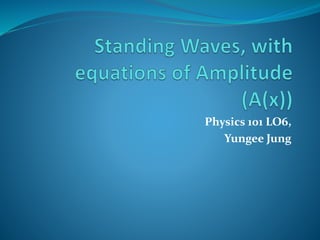
Lo6
- 1. Physics 101 LO6, Yungee Jung
- 2. Standing Wave- What is it? Two harmonic waves, with same amplitude, wavelength, and frequency that are moving in opposite directions Unlike a traveling wave, the “x” (position) is in a sin function while the “t” (time) is in the cosine function. Full equation of Standing wave: D(x,t) = 2A(kx)cos(wt) (where “w” is omega)
- 3. Where did this equation come from? There is a position dependent Amplitude : A(x) Which is : A(x) = 2Asin(kx) Therefore, replacing this in the original Standing wave equation of (D(x,t) = 2A(kx)cos(wt) ) We can simplify the equation to: D(x,t) = A(x)cos(wt)
- 4. The Amplitude function with postion Now more onto the Amplitude equation: - Amplitude is a sine function! So, there are certain points where there is zero amplitude. - These “zero” points are called NODES In opposite, when the Amplitude is at its maximum, it is called the ANTINODES.
- 5. Question time! The equation of the amplitude of a standing wave is : A(x) = (0.50 cm)sin(3.00x) Find the: a) Amplitude and wavelength of the consituent travelling wave b) Location of the first 2 nodes and first 2 antinodes
- 6. Solution to problem part A Since A(x) = 2Asin(kx) And from previous equations, k is equal to 2π/λ Therefore, 2A must equal 0.50 cm and 2π/λ equals 3 rads/m 2A = 0.50cm A= 0.25 cm 2π/3=λ λ=2.094m
- 7. Solution to part B Calculating nodes: at nodes, A(x) =0. So, nodes occur when sin((2π/λ )x)=0 Since sin(0)=0, (2π/λ )x = 0 Using the λ=2.094m from part a, The equation of position of nodes is: 0, ± λ/2, ±λ, (for the first 3 nodes positions)
- 8. Solution to part B continued Therefore, the positions of the first 2 nodes are: x=0, x= 2.094/2 The positions of the first two NODES are 0 and 1.047m.
- 9. Antinode equation(Solution to part B) At the antinode of a standing wave, the amplitude A(x) = ±2A - This occurs at the sin max/ min, which is ±1 The equation for the first two antinode positons are: x= ±λ/4, ±3λ/4 Therefore, using λ=2.094, The first 2 antinode positions are x =0.524 and 1.571m